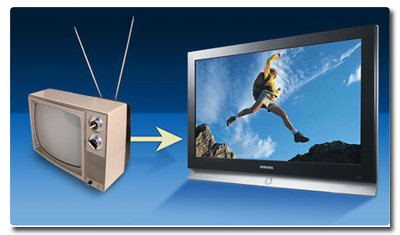|
|
 |
Knowledge Is Key
For Intelligent Decisions
Satellite Logic is a leading,
authoritative source of information in
the Satellite Industry. Located in the
heart of the Silicon Valley, Satellite
Logic provides one of the most
valuable and comprehensive
knowledge bases on the Satellite
market! This is a primary Worldwide
information center which enables our
clients to analyze, evaluate, inquire
and select their best tailored
solutions. Our company sets the
industry standards for targeted
buying leads, reflecting a dramatic
advance over traditional marketing
solutions.
|
|
|
 |

On February 17, 2009, analog broadcasting will end for full-power TV
stations. Currently, most stations are broadcasting in two formats -
digital and analog. Those of us with digital television sets are already
enjoying the benefits of DTV. Those with the older analog sets are still
getting programming as we always have. But that will change on
February 17, 2009, when full-power stations will stop broadcasting in
analog. After that date, they will only broadcast in digital, so you will
have to make some changes if you watch free over-the-air TV
broadcasts on an analog TV with an antenna.
That doesn't mean you need to get a new television set. Buying a digital
TV is just one option. There are low-cost converter boxes to change the
digital signal to one that your current analog set can receive. If you
have video services from AT&T | DIRECTV or AT&T U-verse(SM), you do
not need to make any changes to televisions connected to these
services. If you have AT&T cable services from BellSouth Entertainment,
no changes are necessary at this time but you may receive subsequent
notices related to the BellSouth Entertainment cable offering.
So on February all full-power broadcast stations will complete the
transition from analog to digital broadcasting as mandated by Congress.
The transition to digital fulfills the Federal Communications Commissionís
plan to create more space on the airwaves, much of which will be used
by public safety officials for emergency communications. The switch will
give everyone more programming options and better TV quality but will
affect all viewers differently.

Viewers who use paid TV services wonít be affected by the switch. Only
viewers who watch free over-the-air programming through an antenna
will need to make changes. If you have a digital TV set, you can continue
to receive free over-the-air programming with the same antenna. If you
have an analog TV set and want to continue to receive programming,
you have three options to consider before the switch.
(a) Your analog TV set can receive a digital signal with an easy-to-use
box. With a converter, your TV should continue to receive free programs
through your current antenna. Each TV set in your house that uses an
over-the-air antenna will need its own converter box. The converter box
may be purchased with a government issued coupon through March
2009.
(b) Buy a new TV. Purchasing a digital TV set (ATSC enabled) will allow
you to keep watching free over-the-air programs without a converter.
You will still need an antenna to view free programming, even with the
purchase of a new TV. Since March 2007, all new TVs sold in the U.S. are
required to have digital receivers. A retailer may still sell analog TVs, but
only if they were in stock prior to March 2007. Any analog TVs for sale in
stores must be identifiable to consumers by warning labels that the TVs
will soon require a converter box. When shopping for a new TV, keep in
mind that analog TVs will soon need converters but digital TVs will not.
If youíre interested in High Definition, remember not all digital TV sets
have HD capability.
(c) Choose a paid service. A paid subscription is not required as part of
the switch to digital. But purchasing paid service can give you the latest
technology. Pay TV services typically offer more channels than over-the-
air service, and they also offer many other useful services and features,
such as the ability to record programs on a DVR, watch videos on
demand, view whatís on TV in an electronic program guide, and more.
If the TV has a digital (ATSC) tuner then you would only need an over-
the-air antenna to get digital programming from your local broadcast
stations. You wouldn't need to buy or rent anything for this type of
programming.
If you want digital satellite programming (standard and high definition)
from your cable provider then you will need to subscribe to their digital
programming package. The digital package most likely will only include
standard digital programming. High definition will be an upgrade onto
the digital package, like $10 a month for many cable companies. Buying
or renting a box is dependent on the cable provider but you can rest
assured there will probably be an additional charge for the box one
way or another.
If you buy a TV with a CableCARD slot then you wouldn't necessarily
need the box but would instead need a card from the cable provider.
This card would also be an additional monthly charge but you would
lose the interactivity the cable box would provide. I don't really
recommend relying on a CableCARD slot for programming just yet.
To clarify, the digital transition in the United States of February 17, 2009
only affects reception over the air with an antenna. More importantly, it
will render analog televisions useless without a digital-to-analog
converter box. The digital-to-analog converter box is something you can
buy at many electronics stores or they are provided by your service
provider as part of their digital programming package.
|
|
|
|
